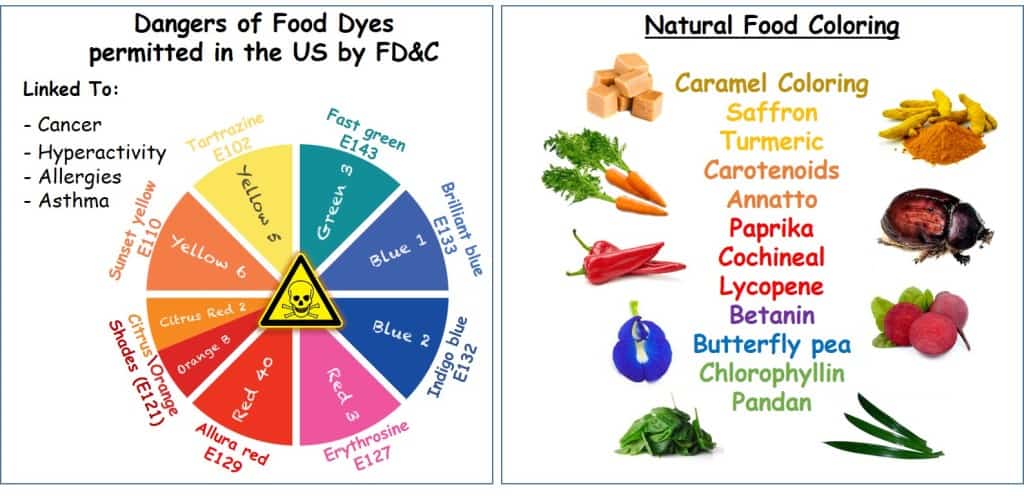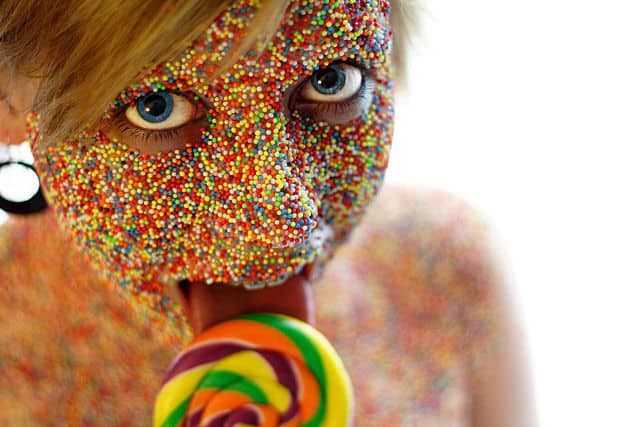Summer is the time for cold tasty sodas and ice cream. Color and flavor are important components of food and drinks. They give food an aesthetic value and increase your appetite or desire to buy this or that colorful tasty product. A lot of food (i.e., sweets, cookies, ice cream, drinks) require addition of extra color dyes. Some of these food additives have natural origin while others are artificial compounds that are considered as dangerous. What is dangerous about the artificial colors? Are natural dyes safer for your health? Let’s learn some useful tips while choosing food in a supermarket or while cooking it in you kitchen.
Artificial food colors are synthesized in the chemical laboratories and are checked for their effect on the human health. Artificial dyes have a great variety of colors and their hues. They are more stable to heat and light than natural compounds, give more bright color and don’t change flavor. That’s why they are used in food. But at the same time, all of them can be really dangerous: a lot of scientific researches show that they cause allergies or hyperactivity in children and adults. A lot of food dyes damage DNA that is the main reason of different cancers. Even those artificial food colors that are permitted in the US by FD&C and are used in drinks and food have great negative effect on our health including cancer diseases.
These colors are used in wide range of popular products. Interesting that these dyes are banned in Europe or other countries considered as dangerous. The same products may contain different food dyes depending on the country: orange color of “Fanta” is determined with the synthetic dyes (Red 40 and Yellow 6) in the US and with carotenoids (carrot or pumpkin extracts) in GB. So, you should always read product labels to know what food colors it contains, especially when you are travelling to other countries.

The alternative is to use the natural dyes extracted from different plants or… animals. Yes, it is incredible but red food pigment carmine widely used in jams is extracted from the cochineal insect larvae. Of course, this liquid is purified so it is not danger or ugly. Other colors can be extracted from widely known and spread plants: orange or yellow (carrot, pumpkin, turmeric), red or purple (beat, blueberry, tomatoes), green (chlorophyll from green leaves), blue (blue flowers – gardenia, butterfly pea), dark brown (caramel, cocoa). Adding of these extracts to food is also an artificial process of food production but they are less dangerous than synthesized compounds.
Some of natural extracts or pigments (i.e., carotenoids, anthocyanins) even can be beneficial for health serving as vitamins or antioxidants. But in spite of the natural origin, some extracts can cause allergy or asthma in adults and children depending on the immune system activity. Furthermore, during the production of caramel color (color of Coca Cola, Pepsi, Brisk Ice Tea, etc.) carcinogenic compound 4-methylimidazole is formed. Scientific studies analyzing concentration of 4-methylimidazole in drinks has shown that some types of soda drinks (Pepsi and Malta Goya) contain increased amounts of this toxic compound. So, think of your health: chose drink and food without artificial colors or containing dyes of natural origin.
Understanding the danger you can limit consumption of color dyes and reduce harm on your health: eat food without bright colors. But if you cannot image your food in dim hues, better pick bright fruits, vegetables, and fresh juice. Furthermore, you can use them to make food dyes yourself having fun and using them to prepare interesting desserts or drinks. If you want to get more extreme colors for your food, you can use fluorescent compounds as described in our previous article.

Chemical industry gives an opportunity to synthesize compounds with different properties for food, medicine, cosmetics uses. But nature is full of bright colors, tastes, and flavors. We can easily use alternative natural food additives. So, get food or drink without artificial colors hazardous for your health. And we offer you to use your summer free time to make food colors, tasty desserts and drinks yourself to surprise friend and relatives.








